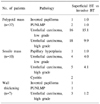Abstract
Purpose
We evaluated the clinical usefulness of air filled axial computed tomography (CT) images and virtual cystoscopy (VC) with using a 64-channel multidetector-row CT (MDCT) scanner for the detection of bladder tumors.
Materials and Methods
Fifty-nine patients who displayed gross hematuria or a clinical suspicion of bladder tumor were scanned using a 64-channel MDCT scanner. The unenhanced CT images of the urinary bladder were obtained, with the patients in the supine and prone positions, following drainage of urine and distension of the bladder with approximately 300-500cc of room air through a urethral catheter. The CT data were transferred to a workstation for reconstructing the VC images. Two radiologists independently interpreted the axial and virtual images, and discrepancies were resolved by working in consensus. The results of the VC were compared with the findings of conventional cystoscopy or the operative findings.
Results
Abnormal findings were identified by the axial CT images and VC in 54 (91.5%) patients. All bladder lesions demonstrated with the VC were seen on conventional cystoscopy. On the VC, lesions greater or equal to 1.4mm in diameter could be identified. But there were 3 false negative findings in cases of sessile masses smaller than 5mm and cases with a trabeculated bladder. There were no false-positive findings. The sensitivity of the technique was 100% for tumors larger than 0.5cm.
Conclusions
VC with using 64-channel MDCT scanner was very accurate at identifying masses larger than 0.5cm and it can show a mass as small as 1.4mm. Bladder tumors can be diagnosed less invasively using air-filled VC. However, in the case with severe bladder trabeculation or wall thickening, we recommend conventional cystoscopy rather than VC.
Figures and Tables
 | Fig. 1Virtual cystoscopic (A) and axial CT (B) images reveal polypoid lesions arising from the right posterolateral wall of the bladder. |
 | Fig. 2Virtual cystoscopic (A), axial CT (B) and conventional cystoscopic (C) images demonstrate a 17mm sized polypoid lesion on the left posterolateral wall. |
 | Fig. 3False negative case. Virtual cystoscopic (A) and axial CT (B) images demonstrate bladder trabeculation only, but conventional cystoscopic image demonstrates a 5mm papillary lesion on the right lateral wall. |
References
1. Denholm SW, Conn IG, Newsam JE, Chisholm GD. Morbidity following cystoscopy: comparison of flexible and rigid techniques. Br J Urol. 1990. 66:152–154.
2. Westenfelder M, Rosset K, Pelz K. Development of nosocomial and iatrogenic urinary tract infections (UTI) following urological interventions. A prospective clinical study. Scand J Urol Nephrol. 1987. 104:Suppl. 59–63.
3. Clark KR, Higgs MJ. Urinary infection following out-patient flexible cystoscopy. Br J Urol. 1990. 66:503–505.
4. Gualdi GF, Casciani E, Rojas M, Polettini E. Virtual cystoscopy of bladder neoplasms. Preliminary experience. Radiol Med (Torino). 1999. 97:506–509.
5. Saksena MA, Dahl DM, Harisinghani MG. New imaging modalities in bladder cancer. World J Urol. 2006. 24:473–480.
6. Webb JA. Imaging in hematuria. Clin Radiol. 1997. 52:167–171.
7. Vining DJ, Zagoria RJ, Liu K, Stelts D. CT cystoscopy: an innovation in bladder imaging. AJR Am J Roentgenol. 1996. 166:409–410.
8. Fenlon HM, Bell TV, Ahari HK, Hussain S. Virtual cystoscopy: early clinical experience. Radiology. 1997. 205:272–275.
9. Tsili AC, Tsampoulas C, Chatziparaskevas N, Silakos A, Kalef-Ezra J, Sofikitis N, et al. Computed tomographic virtual cystoscopy for the detection of urinary bladder neoplasms. Eur Urol. 2004. 46:579–585.
10. Kishore TA, George GK, Bhat S. Virtual cystoscopy by intravesical instillation of dilute contrast medium: preliminary experience. J Urol. 2006. 175:870–874.
11. Kawai N, Mimura T, Nagata D, Tozawa K, Kohri K. Intravenous urography-virtual cystoscopy is a better preliminary examination than air virtual cystoscopy. BJU Int. 2004. 94:832–836.
12. Yazgan C, Fitoz S, Atasoy C, Turkolmez K, Yagci C, Akyar S. Virtual cystoscopy in the evaluation of bladder tumors. Clin Imaging. 2004. 28:138–142.
13. Kim JK, Ahn JH, Park T, Ahn HJ, Kim CS, Cho KS. Virtual cystoscopy of the contrast material-filled bladder in patients with gross hematuria. AJR Am J Roentgenol. 2002. 179:763–768.
14. Song JH, Francis IR, Platt JF, Cohan RH, Mohsin J, Kielb SJ, et al. Bladder tumor detection at virtual cystoscopy. Radiology. 2001. 218:95–100.
15. Narumi Y, Kumatani T, Sawai Y, Kuriyama K, Kuroda C, Takahashi S, et al. The bladder and bladder tumors: imaging with three-dimensional display of helical CT data. AJR Am J Roentgenol. 1996. 167:1134–1135.
16. Fielding JR, Hoyte L, Okon SA, Schreyer A, Lee J, Zou KH, et al. Tumour detection by virtual cystoscopy with color mapping of bladder wall thickness. J Urol. 2002. 167:559–562.
17. Bernhardt TM, Rapp-Bernhardt U. Virtual cystoscopy of the bladder based on CT and MRI data. Abdom Imaging. 2001. 26:325–332.
18. Dondalski M, White EM, Ghahremani GG, Patel SK. Carcinoma arising in urinary bladder diverticula: imaging findings in six patients. AJR Am J Roentgenol. 1993. 161:817–820.
19. Beer A, Saar B, Rummeny EJ. Tumors of the urinary bladder: technique, current use, and perspectives of MR and CT cystography. Abdom Imaging. 2003. 28:868–876.
20. Beer A, Saar B, Zantl N, Link TM, Roggel R, Hwang SL, et al. MR cystography for bladder tumor detection. Eur Radiol. 2004. 14:2311–2319.
21. Mitterberger M, Pinggera GM, Neuwirt H, Maier E, Akkad T, Strasser H, et al. Three-dimensional ultrasonography of the urinary bladder: preliminary experience of assessment in patients with haematuria. BJU Int. 2007. 99:111–116.




 PDF
PDF ePub
ePub Citation
Citation Print
Print








 XML Download
XML Download